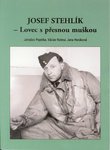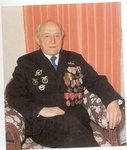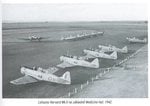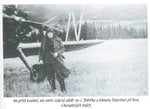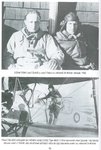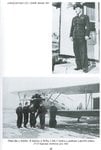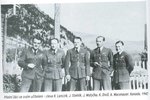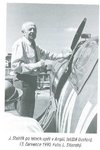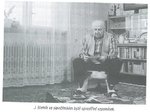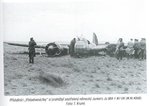Navigation
Install the app
How to install the app on iOS
Follow along with the video below to see how to install our site as a web app on your home screen.
Note: This feature may not be available in some browsers.
More options
You are using an out of date browser. It may not display this or other websites correctly.
You should upgrade or use an alternative browser.
You should upgrade or use an alternative browser.
S/Ldr Josef Stehlík - In Four Airforces
- Thread starter Pisis
- Start date
Ad: This forum contains affiliate links to products on Amazon and eBay. More information in Terms and rules
More options
Who Replied?seesul
Senior Master Sergeant
Hello Pisis,
I was born in Slavicin but hadn´t many chances to speak to him as he passed away too soon in 1991 and I was 17 back then. Anyway, we got him on visit in our school in 1987- what a discussion! I can remebemer his description of his first kill (in cooperation) of 312.Sqdn over Liverpool yet...
Roman
- Thread starter
- #3
Pisis
2nd Lieutenant
Čau,
well, lucky you. How was that possible to speak about it in 1987? It amazes me. I know there were a few articles in L&K (main aviation magazine) per year about the heroism of Czechoslovak airmen in "The West", but as far as I know, it was unable to speak openly about this theme but until the fall of the communism in 1989... So you were double lucky.
Thanks for the info.
well, lucky you. How was that possible to speak about it in 1987? It amazes me. I know there were a few articles in L&K (main aviation magazine) per year about the heroism of Czechoslovak airmen in "The West", but as far as I know, it was unable to speak openly about this theme but until the fall of the communism in 1989... So you were double lucky.
Thanks for the info.
seesul
Senior Master Sergeant
Well, that´s right...
But I was interrested in WW2 history and especially in aviation and war in Pacific.
So I´ve asked our history teacher if it would be possible to invite him to the scholl and open a discussion with him, she agreed and organized it.
Sure, he didn´t mention any word about his fate and experience after WWII but anyway, it was very interresting to see and hear a real hero back then... You could hear a pin falling down on the ground when he was speaking in the school class...
I like to speak to WW2 vets and always have goose flesh when they speak...
We met Willi Reschke in Germany last year and he visited us here in Slavicin and Banov last year (see http://www.ww2aircraft.net/forum/album/showphoto.php?photo=14110&cat=602 ). I´ve also found the adress of Hansotto Nehls from 11/JG300 and am in touch with his daughter. He unfortunatelly passed away in 2004... What a pity... In Slavicin museum we have rests from his Bf109G-6AS...
Have a friend in USA that bailed out from his burning B-17G on Aug 29th 1944.
He visited us here in 2005 and we visited him in New Jersey last year. He´s going to visit us this year again with his grandson and Todd Weiler, nephew of James Weiler, whose B-17 went down on the same day. Term of thier visit is Aug 23rd-Sept. 3rd and there will be a commemoration in Rudice on Sat 25th and meeting in Slavicin museum on Sun 26th.
Ahoj
But I was interrested in WW2 history and especially in aviation and war in Pacific.
So I´ve asked our history teacher if it would be possible to invite him to the scholl and open a discussion with him, she agreed and organized it.
Sure, he didn´t mention any word about his fate and experience after WWII but anyway, it was very interresting to see and hear a real hero back then... You could hear a pin falling down on the ground when he was speaking in the school class...
I like to speak to WW2 vets and always have goose flesh when they speak...
We met Willi Reschke in Germany last year and he visited us here in Slavicin and Banov last year (see http://www.ww2aircraft.net/forum/album/showphoto.php?photo=14110&cat=602 ). I´ve also found the adress of Hansotto Nehls from 11/JG300 and am in touch with his daughter. He unfortunatelly passed away in 2004... What a pity... In Slavicin museum we have rests from his Bf109G-6AS...
Have a friend in USA that bailed out from his burning B-17G on Aug 29th 1944.
He visited us here in 2005 and we visited him in New Jersey last year. He´s going to visit us this year again with his grandson and Todd Weiler, nephew of James Weiler, whose B-17 went down on the same day. Term of thier visit is Aug 23rd-Sept. 3rd and there will be a commemoration in Rudice on Sat 25th and meeting in Slavicin museum on Sun 26th.
Ahoj
- Thread starter
- #5
Pisis
2nd Lieutenant
Fine, let's keep in touch then.
seesul
Senior Master Sergeant
... and btw, there´s a small pub in Slavicin. Josef Stehlik used to go there to play the cards, I met him there several times when I was there with my father. I guess you know his stories and know that he was an excellent cards player....
The name of this pub is ''U Pilota''.
Bye
The name of this pub is ''U Pilota''.
Bye
- Thread starter
- #7
Pisis
2nd Lieutenant
Well, I didn't know that actually.
seesul
Senior Master Sergeant
- Thread starter
- #9
Pisis
2nd Lieutenant
Dík, I didn't know about those books! 
seesul
Senior Master Sergeant
Don´t know if you know it but there´s a nice true story- when Joe drove by ship (Queen Mary) to Canada he played the cards with the captain of this ship and naturaly won....a lot of money.
This captain even put the note into the log book-''today I played the cards and lost for a first time in my life with a little Joe from Czechoslovakia''
When Joe arrived to Canada he even bought a used Ford 8 for this money there
Queen Mary is anchored in Long Beach USA and captain´s log book is still a part of this ship...
My neighbour used to play the cards with Joe often in the pub but never won
This captain even put the note into the log book-''today I played the cards and lost for a first time in my life with a little Joe from Czechoslovakia''
When Joe arrived to Canada he even bought a used Ford 8 for this money there
Queen Mary is anchored in Long Beach USA and captain´s log book is still a part of this ship...
My neighbour used to play the cards with Joe often in the pub but never won
seesul
Senior Master Sergeant
seesul
Senior Master Sergeant
Pisis, he also served as a flying instructor in Canada in 1942, where he trained new Czech pilots and one of them was Otto Smik...
Attached few pics from Canada...
Source: above mentioned book
Attached few pics from Canada...
Source: above mentioned book
Attachments
seesul
Senior Master Sergeant
Pisis, our former Czech president, Václav Havel met him in in May 1945 as a kid... Here is a part of the letter that Václav Havel sent to Stehlík´s wife Marie in 90´s:
'' Možná s budete divit, ale mám dodnes v živé paměti, jak Váš zesnulý manžel přistál s letadlem po 9. květnu 1945 v blízkosti Havlova a pak byl u nás na večeři. Bylo mi tehdy devět let a obdivoval jsem ho jako hrdinu a navíc se mi líbila ho anglická uniforma.''
'' Možná s budete divit, ale mám dodnes v živé paměti, jak Váš zesnulý manžel přistál s letadlem po 9. květnu 1945 v blízkosti Havlova a pak byl u nás na večeři. Bylo mi tehdy devět let a obdivoval jsem ho jako hrdinu a navíc se mi líbila ho anglická uniforma.''
Airframes
Benevolens Magister
Fascinating! I think it was Josef who was featured in a small article in the (British) 'Fly Past' magazine some years back, when a Spitfire returned to Czech Republic for the first time since the end of the war. There's a picture of him sitting in the cockpit of the (present day) Spitfire. I think I still have the mag and, if so, and I can find it (!), I'll post the article. I always think that the average 'Brit' doesn't realise the debt we owe to Czechs, and Poles, who fought so hard and valiantly alongside our own, Commonwealth and other allied airmen, particularly in the early years of the war.
Terry.
Terry.
seesul
Senior Master Sergeant
seesul
Senior Master Sergeant
seesul
Senior Master Sergeant
Joe last decoration...He should get it at Prague Castle during ceremony on May 8, 1991. Due to his health problems he couldn´t receive it personally so the Czech Army officers decided to bring it to him to Slavicin on May 30th, 1991.
Joe passed away in the night May 29/30, 1991...few hours before we should get this decoration...he was buried on June 8, 1991. I attended at the funeral service with my father and still have it in my memory...
That building behind the soldier holding the decoration is Slavicin castle. There´a a nice pub inside this castle and every time I go to Slavicin for a weekend to see my parents and friends, I go there for a beer. Since 2001 I live in Zlin (some 25 miles away), but my parents, my best friends and my heart are still there. I´m there every 2nd-3rd weekend...
As I mentioned before, there´a also another pub called ''U pilota'' where Joe used to play cards often. Next time, when I´ll be in Slavicin, I´ll take a picture of this pub and post it here...
Joe passed away in the night May 29/30, 1991...few hours before we should get this decoration...he was buried on June 8, 1991. I attended at the funeral service with my father and still have it in my memory...
That building behind the soldier holding the decoration is Slavicin castle. There´a a nice pub inside this castle and every time I go to Slavicin for a weekend to see my parents and friends, I go there for a beer. Since 2001 I live in Zlin (some 25 miles away), but my parents, my best friends and my heart are still there. I´m there every 2nd-3rd weekend...
As I mentioned before, there´a also another pub called ''U pilota'' where Joe used to play cards often. Next time, when I´ll be in Slavicin, I´ll take a picture of this pub and post it here...
Attachments
seesul
Senior Master Sergeant
Joe, in cooperation with P/O Alois Vasatko and F/Lt Dennys Gillam, shot down Ju-88A-1 M7-DK, W.Nr. 4068 on October 8,1940 over Liverpool. It was a first 312.Sqdn kill.
Here is the story:
On the 8th October 1941 Junkers Ju88 Wk No 4068 coded M7+DK, of KG 2/806 took of from its base at Caen-Carpignet in France to bomb the Rootes aircraft factory at Speke and photograph the results, the aircraft was loaded with four 250 kg bombs. The route that was taken took them from Caen to Southampton to Droitwich to Ellesmere Port and finally to Speke arriving in the target area around 16:00 hours. One member of the crew was a "Bildberichter" (Photographic War Correspondent).
From his vantage point on the top of George Henry Lee department store in the centre of Liverpool, Les Jones was on look out duty for enemy aircraft at the time, spotted and identified the loneJu88 flying up the River Mersey. H W Mermagen was the Station Commander at Speke and was in the operations room were the incoming raid was being plotted and gave the order for a flight of No 312 (Czech) squadron to be scrambled as the raider was thought to be heading for Liverpool.
Before reaching the objective, whilst flying at 13,000 feet the aircraft was attacked by three Hurricanes of Yellow section No 312 (Czech) squadron based at Speke. The starboard engine was hit and damaged and the pilot made a forced landing with the undercarriage retracted at Bromborough Dock at 16:15 hours, with two bombs still in their racks, upon being attacked two of the bombs were jettisoned into the river the other two remaining on the aircraft. The Ju88 slid across the field for thirty yards until it came to rest with the port engine ripped out of its mountings, one of the bombs was also torn from its rack to be found lying in the field near to the aircraft. The Ju88 came to a rest near to a anti aircraft gun post, the solders from which came to arrest the remaining crewmembers, however one of the crew that was slightly wounded in the hand and was taken to nearby Claterbridge hospital. The observer Leutnant Herbert Schlegel was killed by a bullet wound to the head, the air gunner and wireless operator were injured on landing and the second pilot was uninjured. The morale of the crew after being captured was considered to be very high.
Yellow section No 312 (Czech) squadron had taken at 16:10 hours with orders to patrol Hoylake and while still at a height of 1,000 feet anti aircraft bursts drew their attention to an enemy aircraft. On sighting the Hurricanes the Ju88 started to climb sharply trying to gain cloud cover and was actively pursued. Sergeant Josef Stehlik in L1807 got in the first burst and Pilot Officer Alois Vasatko in L1926 continued firing from below and above in quarter tactics. Meanwhile Flight Lieutenant Denys Gillam in P2575 kept up stern attacks and soon the Ju88 was seen to be gliding downwards with both of its engines on fire, landing in a field on the opposite side of the Mersey. Heavy and accurate fire was experienced from the Ju88 up to the last minute and all three hurricanes were damaged with Flight Lieutenant Gillam's windscreen being smashed.
The pilots got a hearty reception when they landed being carried shoulder high by their comrades, a large number of station personnel and local civilians witnessed the event, including those on a local bus going past the Airport. So great was the interest that the airport gates had to be closed the following day when crowds of local civilians arrived wanting to congratulate the pilots.
The intelligence officer, Pilot Officer G McK Phillips report that is made up from the three pilots individual combat reports details the attack as follows, "Yellow section had just received the order to patrol Hoylake and were still near the aerodrome at a height of 1000 feet when a Ju88 was sighted by anti aircraft positions up river the bursts attracting the attention of yellow 3 which sighted the Ju88 flying slowly Westwards at 1200 feet. The Ju88 then in turn sighted our formation and climbed sharply trying to gain cloud cover. Shortly before entering the Ju88 received a burst from Yellow 3 which was followed by continual attacks from Yellow 1(continuous astern attacks) Yellow 2 and 3 which weaved in and out attacking from below and above principally from the rear on account of bad visibility. The Ju88 received bursts from Yellow 1 and 3 while still climbing through cloud and started gliding downwards. Yellow 2 and 3 doing quarter attacks. By this time both of the Ju88's engines were on fire and it was seen by yellow 2 and a large number of ground observers to fall flat down on a meadow on the left bank of the Mersey. During combat heavy and accurate return fire was experienced from the Ju88 up to the last moment before the crash. Slight damage was sustained by all our aircraft a bullet hitting the windscreen of Yellow 1 another the exhaust manifolds of Yellow 2 while Yellow 3 sustained damage to the petrol tank and the gun pipe line (He states in his individual report he returned thinking all his ammunition had gone). Cine guns were not carried. Anti Aircraft fire was ceased immediately our fighters came into action. The names of the pilots taking part and numbers of rounds fired were as follows,
bullet Yellow 1. Flight Lieutenant D.E. Gillam A.F.C 2400
bullet Yellow 2. Pilot Officer A. Vasatko 144
bullet Yellow 3. Sergeant J. Stehlik 504
This was 312 (Czech) Squadrons first combat since formation on 29/8/1940.
In his memoirs Flight Lieutenant Gillam recalled the events of the engagement, we were scrambled on 8th October in poor visibility. With our wheels still down we spotted this Ju88 being engaged by AA fire. My two wingmen began to chase it as I pulled up into a climbing turn. As my two Czechs engaged him I rolled or rather slid off the top of the climb right under it – the Ju88 was only at 1,000 feet. When I had enough power I pulled up and got a very close shot and it went down and crash landed with both engines on fire on the other side of the Mersey, about half a mile or so from the airfield. I continued round, lowered my wheels and put back down on the runway. It must have been one of the fastest Fighter Command kills on record. I had a bullet hit my windshield, in fact the German gunner scored hits on all three hurricanes. Taking my car, I drove through the Mersey Tunnel to the scene of the crash just as the crew was being rounded up. The pilot was dead but the others had survived although the gunner and wireless operator had been injured. I cut the German badge off the side of the aeroplane together with one of the swastikas four souvenirs, then returned to Speke".
The local newspaper recorded "It was a great few minutes and that Ju88 simply had no chance", said an experienced airman and "I saw the leading British fighter come back, I looked for a victory roll, there was none. The second Hurricane and then the third Hurricane came. They did no Victory Roll either, then as an old flying man I understood, none of them would take the credit individually".
Junkers Ju88A-1 Wk No 4068 was built by Norddeutsche Dornier Werke under license from Junkers and was accepted in May 1940. The port Jumo 211 engine was built by Junkers and the Starboard one was built by Miteldeutsche Motorem Werke, Leipzig. The Ju88 was armed with 5-6 machine guns and carried the usual armour plating. There was also a crest painted onto the nose of the Ju88 and comprised of a German eagle in flight carrying an Iron Cross with a small Swastika superimposed on red, white and blue concentric circles, the inner ring was partly green and partly white, this was probably the crews own badge. At least six 0.303" rounds were found in the starboard engine...
Source: Shooting down of a Ju88 by No 312 Squadron
Here is the story:
On the 8th October 1941 Junkers Ju88 Wk No 4068 coded M7+DK, of KG 2/806 took of from its base at Caen-Carpignet in France to bomb the Rootes aircraft factory at Speke and photograph the results, the aircraft was loaded with four 250 kg bombs. The route that was taken took them from Caen to Southampton to Droitwich to Ellesmere Port and finally to Speke arriving in the target area around 16:00 hours. One member of the crew was a "Bildberichter" (Photographic War Correspondent).
From his vantage point on the top of George Henry Lee department store in the centre of Liverpool, Les Jones was on look out duty for enemy aircraft at the time, spotted and identified the loneJu88 flying up the River Mersey. H W Mermagen was the Station Commander at Speke and was in the operations room were the incoming raid was being plotted and gave the order for a flight of No 312 (Czech) squadron to be scrambled as the raider was thought to be heading for Liverpool.
Before reaching the objective, whilst flying at 13,000 feet the aircraft was attacked by three Hurricanes of Yellow section No 312 (Czech) squadron based at Speke. The starboard engine was hit and damaged and the pilot made a forced landing with the undercarriage retracted at Bromborough Dock at 16:15 hours, with two bombs still in their racks, upon being attacked two of the bombs were jettisoned into the river the other two remaining on the aircraft. The Ju88 slid across the field for thirty yards until it came to rest with the port engine ripped out of its mountings, one of the bombs was also torn from its rack to be found lying in the field near to the aircraft. The Ju88 came to a rest near to a anti aircraft gun post, the solders from which came to arrest the remaining crewmembers, however one of the crew that was slightly wounded in the hand and was taken to nearby Claterbridge hospital. The observer Leutnant Herbert Schlegel was killed by a bullet wound to the head, the air gunner and wireless operator were injured on landing and the second pilot was uninjured. The morale of the crew after being captured was considered to be very high.
Yellow section No 312 (Czech) squadron had taken at 16:10 hours with orders to patrol Hoylake and while still at a height of 1,000 feet anti aircraft bursts drew their attention to an enemy aircraft. On sighting the Hurricanes the Ju88 started to climb sharply trying to gain cloud cover and was actively pursued. Sergeant Josef Stehlik in L1807 got in the first burst and Pilot Officer Alois Vasatko in L1926 continued firing from below and above in quarter tactics. Meanwhile Flight Lieutenant Denys Gillam in P2575 kept up stern attacks and soon the Ju88 was seen to be gliding downwards with both of its engines on fire, landing in a field on the opposite side of the Mersey. Heavy and accurate fire was experienced from the Ju88 up to the last minute and all three hurricanes were damaged with Flight Lieutenant Gillam's windscreen being smashed.
The pilots got a hearty reception when they landed being carried shoulder high by their comrades, a large number of station personnel and local civilians witnessed the event, including those on a local bus going past the Airport. So great was the interest that the airport gates had to be closed the following day when crowds of local civilians arrived wanting to congratulate the pilots.
The intelligence officer, Pilot Officer G McK Phillips report that is made up from the three pilots individual combat reports details the attack as follows, "Yellow section had just received the order to patrol Hoylake and were still near the aerodrome at a height of 1000 feet when a Ju88 was sighted by anti aircraft positions up river the bursts attracting the attention of yellow 3 which sighted the Ju88 flying slowly Westwards at 1200 feet. The Ju88 then in turn sighted our formation and climbed sharply trying to gain cloud cover. Shortly before entering the Ju88 received a burst from Yellow 3 which was followed by continual attacks from Yellow 1(continuous astern attacks) Yellow 2 and 3 which weaved in and out attacking from below and above principally from the rear on account of bad visibility. The Ju88 received bursts from Yellow 1 and 3 while still climbing through cloud and started gliding downwards. Yellow 2 and 3 doing quarter attacks. By this time both of the Ju88's engines were on fire and it was seen by yellow 2 and a large number of ground observers to fall flat down on a meadow on the left bank of the Mersey. During combat heavy and accurate return fire was experienced from the Ju88 up to the last moment before the crash. Slight damage was sustained by all our aircraft a bullet hitting the windscreen of Yellow 1 another the exhaust manifolds of Yellow 2 while Yellow 3 sustained damage to the petrol tank and the gun pipe line (He states in his individual report he returned thinking all his ammunition had gone). Cine guns were not carried. Anti Aircraft fire was ceased immediately our fighters came into action. The names of the pilots taking part and numbers of rounds fired were as follows,
bullet Yellow 1. Flight Lieutenant D.E. Gillam A.F.C 2400
bullet Yellow 2. Pilot Officer A. Vasatko 144
bullet Yellow 3. Sergeant J. Stehlik 504
This was 312 (Czech) Squadrons first combat since formation on 29/8/1940.
In his memoirs Flight Lieutenant Gillam recalled the events of the engagement, we were scrambled on 8th October in poor visibility. With our wheels still down we spotted this Ju88 being engaged by AA fire. My two wingmen began to chase it as I pulled up into a climbing turn. As my two Czechs engaged him I rolled or rather slid off the top of the climb right under it – the Ju88 was only at 1,000 feet. When I had enough power I pulled up and got a very close shot and it went down and crash landed with both engines on fire on the other side of the Mersey, about half a mile or so from the airfield. I continued round, lowered my wheels and put back down on the runway. It must have been one of the fastest Fighter Command kills on record. I had a bullet hit my windshield, in fact the German gunner scored hits on all three hurricanes. Taking my car, I drove through the Mersey Tunnel to the scene of the crash just as the crew was being rounded up. The pilot was dead but the others had survived although the gunner and wireless operator had been injured. I cut the German badge off the side of the aeroplane together with one of the swastikas four souvenirs, then returned to Speke".
The local newspaper recorded "It was a great few minutes and that Ju88 simply had no chance", said an experienced airman and "I saw the leading British fighter come back, I looked for a victory roll, there was none. The second Hurricane and then the third Hurricane came. They did no Victory Roll either, then as an old flying man I understood, none of them would take the credit individually".
Junkers Ju88A-1 Wk No 4068 was built by Norddeutsche Dornier Werke under license from Junkers and was accepted in May 1940. The port Jumo 211 engine was built by Junkers and the Starboard one was built by Miteldeutsche Motorem Werke, Leipzig. The Ju88 was armed with 5-6 machine guns and carried the usual armour plating. There was also a crest painted onto the nose of the Ju88 and comprised of a German eagle in flight carrying an Iron Cross with a small Swastika superimposed on red, white and blue concentric circles, the inner ring was partly green and partly white, this was probably the crews own badge. At least six 0.303" rounds were found in the starboard engine...
Source: Shooting down of a Ju88 by No 312 Squadron
Attachments
seesul
Senior Master Sergeant
...Harry Gill who was a gateman at Brombourgh Dock at the time recalled, "The air raid siren had sounded but in those days nobody paid much attention to them. I was on duty at the South Gatehouse at Bromborough dock, when a twin-engined aeroplane plunged out of the clouded sky and crashed about 200 yards away on land reclaimed from the River Mersey. I ran towards it and half way there I looked up and saw a swastika on the tail fin. Two men were scrambled out of the cockpit and ran behind the damaged wing. The two Germans who were tall and well built were bending over a third airman lying at their feet. I sized them by the epaulettes of their uniforms and demanded their guns, which they surrendered without argument. Mr Rand and Thompson then appeared at my side, Mr Thompson took charge of one of the Germans and escorted him to the Dock Gatehouse to be kept in custody until the military authorities arrived".
"One of the crew was found to be dead at the controls, alongside the Ju88 was a fully inflated dingy, and two unexploded bombs which had fallen from the aircraft as it bounced along the ground were lying near the smoking port engine. At that stage of the war, a military unit was stationed near the dock and they mounted a guard over the aircraft until it was removed by the RAF. The Air force were very concerned with the bombsight as it was a new type and was the first to fall in our hands, they carefully dismantled it and brought it to the Gatehouse where my colleagues and I kept it under guard until it was taken away".
"That evening we were visited by the three pilots who shot the Ju88 down, having been the first to approach the Ju88, it seemed a fitting conclusion to an exiting day when I shook hands with the victors".
Frank "Doc" Holmes recalled the event in his memoirs "On the 8th October 1940 I was standing my door step at 30Ashfield road when the sirens sounded, in the air above us was a German Ju88 with three of our fighters chasing it and it was firing back at them. The fighters were Hurricanes. The Ju88 veered and nearly hit Bromborough church steeple, but the fighters got the better of it and shot it down near Brombourgh dock. I had a good idea were it crashed, so I picked up my eldest boy Barry aged 6 years and put him on the crossbar of my bicycle and made my way to where the Ju88 had come down. When we arrived the crew had been removed from the plane. The pilot, only a very young man was killed and the co pilot was wounded. The machine gunner was not to badly hurt. They were all taken to Claterbridge Hospital. It was a sad sight to see, but that is war.
A pilot arrived on the scene about 15 minutes after the Ju88 was shot down, he had come all the way from Speke Airport where he had left hi Hurricane. He was also a very young man. He cut the German badge off the side of the Ju88, also one of the Swastikas, got back in his car and left for Speke and home. Of course the Army were called in to guard the Ju88 and surround it with ropes and posts. There was a bunch of keys lying on the ground near the plane, which I picked up and gave to one of the soldiers on guard and while doing so had a quick look inside, I was sorry I did because it was not a petty site at all. I did notice that in the glove compartment of the Ju88 there was a bar of Cadbury's Chocolate and a pack of Churchman's cigarettes which must have come from the Dunkirk campaign".
The aircraft was removed by the RAF within a few days and it was announced on the 9th October 1940 by the Commander of the Merseyside Garrison that the aircraft was to be put on public view in connection with "War weapons Week" in Liverpool the following week. In the meantime the JU88 was moved to the Oval Recreation Ground were it was placed on display to the public. More than £70 was collected for the Mayor of Bebington's "Spitfire Fund". On the 18th October 1940 the Ju88 was paraded through the streets of Liverpool in procession with University students, the aircraft was later displayed at St George's Plateau alongside a Messerschmitt Bf 109. The Ju88 was later taken to RAF Sealand and disposed of. The Swastika panel from the tailfin was taken by the pilots as a souvenir and was hung in the flight hut at the squadron dispersal, after the war Flight Lieutenant Gillam presented this panel to RAF Finingley and since the recent closure of this airfield the panels whereabouts are unknown. A paddle from the dinghy which had a plaque mounted on it along with a painting titled "The Fastest Victory" signed by Flight Lieutenant Gillam was recently seen for sale on an Internet site.
Lieutenant Herbert Schlegel was originally buried at Hooton Village Church yard and was moved in 1962 to the German military cemetery at Cannock, Staffordshire, Block grave No 3, grave no 117.
Born Hamburg in 1914, Helmuth Bruckman graduated from school in Emden in 1934, enlisting into the German Navy the same year and commencing flying training in 1936, he was promoted to Oberleutnant in 1939 and was made Commanding Officer of a coastal reconnaissance squadron, aircraft carrier group and subsequently Director of a pilot training school. Early in WWII he became deputy Squadron Leader in a bomber wing, regularly flying He111 and Junkers 88 bomber aircraft. After 36 missions Helmuth Bruckmann's war was over. Promotion to Captain followed in 1942, and he was repatriated in 1944. He joined the Luftwaffe general staff and was promoted to major in 1945. On leaving the air force Helmuth studied languages and literature at university from 1946-1958 and became director of the Goethe Institute in Munich. He rejoined the Luftwaffe and became a Lt Colonel in 1959 in the Ministry of Defence, Bonn. After a period as Commander of a cadet training wing in the Luftwaffe Officers Training School in Munich, he was promoted to full Colonel in 1961 and transferred to the German Embassy in Washington D.C. USA as air attaché. After an additional assignment as the German Military representative with the NATO committee, he returned to Germany as head of the Military Studies Group in the German Ministry of Defence. He retired in 1973. Between the 1st and 3rd November 1992 Helmuth Bruckman visited the area and flew back into the same field that he crash landed his Ju88 into, aboard the Duke of Westminster's helicopter. He had hoped to have met Denys Gillam but he had unfortunately died of a heart attack only a few weeks earlier.
KGr 806 was formed in September 1939, originally as a coastal bomber reconnaissance unit, which was absorbed into the Luftflotte as an orthodox bomber group, still retaining its nucleus of naval officers. Based at Nantes with detachments at Caen. Originally equipped with Heinkel He111, it was equipped with Ju88A-1 before and during the Battle of Britain. KGr 806 also saw operational service on the Eastern Front and Mediterranean.
No 312 (Czech) Squadron came into being as the second Czechoslovak fighter unit and was formed on 29th August 1940 at the Czech aircrew depot at RAF Cosford. The home base of the squadron was RAF Duxford, the same airfield where No 310 (Czech) Squadron was based . Two days later the first nine used Hawker Hurricanes Mk1 were flown into Duxford and on the 4th September 1940 arrived a Miles Master Mk1. Czech airmen, flying personnel and ground staff, arrived at RAF Duxford during afternoon of the 5th September 1940. The squadron was based around experienced pilots, who had already had combat experience during the Battle of France, many of whom had already had more then one victory. On the 6th September 1940, the pilots began with theoretical preparation for flying on the Hurricanes and with training flights on the Master. The training was very slow due to the fact the unit had just one trainer aircraft. For faster retraining of the pilots, another Master was loaned from No 310 (Czech) Squadron. After nearly a month the level of training was very high and on the 26th September the squadron moved to its new home, the RAF station at Speke airport, Liverpool. There the unit completed its retraining and in last days of September obtained further Hurricanes. On the 2nd October 1940, No 312 (Czech) Squadron was declared as operational and its task was to protect the Liverpool area from enemy raids. The squadron left Speke for RAF Valley on Anglesey, on the 3rd March 1941. The squadrons motto was, Non multi sed multa - 'Not many but much' and the squadron badge was, A stork Volant. The stork in the badge relates to the French 'Escadrille des Cygelines' with whom the original pilots of No 312 (Czech) squadron had flown prior to coming to the UK.
Source: Shooting down of a Ju88 by No 312 Squadron
"One of the crew was found to be dead at the controls, alongside the Ju88 was a fully inflated dingy, and two unexploded bombs which had fallen from the aircraft as it bounced along the ground were lying near the smoking port engine. At that stage of the war, a military unit was stationed near the dock and they mounted a guard over the aircraft until it was removed by the RAF. The Air force were very concerned with the bombsight as it was a new type and was the first to fall in our hands, they carefully dismantled it and brought it to the Gatehouse where my colleagues and I kept it under guard until it was taken away".
"That evening we were visited by the three pilots who shot the Ju88 down, having been the first to approach the Ju88, it seemed a fitting conclusion to an exiting day when I shook hands with the victors".
Frank "Doc" Holmes recalled the event in his memoirs "On the 8th October 1940 I was standing my door step at 30Ashfield road when the sirens sounded, in the air above us was a German Ju88 with three of our fighters chasing it and it was firing back at them. The fighters were Hurricanes. The Ju88 veered and nearly hit Bromborough church steeple, but the fighters got the better of it and shot it down near Brombourgh dock. I had a good idea were it crashed, so I picked up my eldest boy Barry aged 6 years and put him on the crossbar of my bicycle and made my way to where the Ju88 had come down. When we arrived the crew had been removed from the plane. The pilot, only a very young man was killed and the co pilot was wounded. The machine gunner was not to badly hurt. They were all taken to Claterbridge Hospital. It was a sad sight to see, but that is war.
A pilot arrived on the scene about 15 minutes after the Ju88 was shot down, he had come all the way from Speke Airport where he had left hi Hurricane. He was also a very young man. He cut the German badge off the side of the Ju88, also one of the Swastikas, got back in his car and left for Speke and home. Of course the Army were called in to guard the Ju88 and surround it with ropes and posts. There was a bunch of keys lying on the ground near the plane, which I picked up and gave to one of the soldiers on guard and while doing so had a quick look inside, I was sorry I did because it was not a petty site at all. I did notice that in the glove compartment of the Ju88 there was a bar of Cadbury's Chocolate and a pack of Churchman's cigarettes which must have come from the Dunkirk campaign".
The aircraft was removed by the RAF within a few days and it was announced on the 9th October 1940 by the Commander of the Merseyside Garrison that the aircraft was to be put on public view in connection with "War weapons Week" in Liverpool the following week. In the meantime the JU88 was moved to the Oval Recreation Ground were it was placed on display to the public. More than £70 was collected for the Mayor of Bebington's "Spitfire Fund". On the 18th October 1940 the Ju88 was paraded through the streets of Liverpool in procession with University students, the aircraft was later displayed at St George's Plateau alongside a Messerschmitt Bf 109. The Ju88 was later taken to RAF Sealand and disposed of. The Swastika panel from the tailfin was taken by the pilots as a souvenir and was hung in the flight hut at the squadron dispersal, after the war Flight Lieutenant Gillam presented this panel to RAF Finingley and since the recent closure of this airfield the panels whereabouts are unknown. A paddle from the dinghy which had a plaque mounted on it along with a painting titled "The Fastest Victory" signed by Flight Lieutenant Gillam was recently seen for sale on an Internet site.
Lieutenant Herbert Schlegel was originally buried at Hooton Village Church yard and was moved in 1962 to the German military cemetery at Cannock, Staffordshire, Block grave No 3, grave no 117.
Born Hamburg in 1914, Helmuth Bruckman graduated from school in Emden in 1934, enlisting into the German Navy the same year and commencing flying training in 1936, he was promoted to Oberleutnant in 1939 and was made Commanding Officer of a coastal reconnaissance squadron, aircraft carrier group and subsequently Director of a pilot training school. Early in WWII he became deputy Squadron Leader in a bomber wing, regularly flying He111 and Junkers 88 bomber aircraft. After 36 missions Helmuth Bruckmann's war was over. Promotion to Captain followed in 1942, and he was repatriated in 1944. He joined the Luftwaffe general staff and was promoted to major in 1945. On leaving the air force Helmuth studied languages and literature at university from 1946-1958 and became director of the Goethe Institute in Munich. He rejoined the Luftwaffe and became a Lt Colonel in 1959 in the Ministry of Defence, Bonn. After a period as Commander of a cadet training wing in the Luftwaffe Officers Training School in Munich, he was promoted to full Colonel in 1961 and transferred to the German Embassy in Washington D.C. USA as air attaché. After an additional assignment as the German Military representative with the NATO committee, he returned to Germany as head of the Military Studies Group in the German Ministry of Defence. He retired in 1973. Between the 1st and 3rd November 1992 Helmuth Bruckman visited the area and flew back into the same field that he crash landed his Ju88 into, aboard the Duke of Westminster's helicopter. He had hoped to have met Denys Gillam but he had unfortunately died of a heart attack only a few weeks earlier.
KGr 806 was formed in September 1939, originally as a coastal bomber reconnaissance unit, which was absorbed into the Luftflotte as an orthodox bomber group, still retaining its nucleus of naval officers. Based at Nantes with detachments at Caen. Originally equipped with Heinkel He111, it was equipped with Ju88A-1 before and during the Battle of Britain. KGr 806 also saw operational service on the Eastern Front and Mediterranean.
No 312 (Czech) Squadron came into being as the second Czechoslovak fighter unit and was formed on 29th August 1940 at the Czech aircrew depot at RAF Cosford. The home base of the squadron was RAF Duxford, the same airfield where No 310 (Czech) Squadron was based . Two days later the first nine used Hawker Hurricanes Mk1 were flown into Duxford and on the 4th September 1940 arrived a Miles Master Mk1. Czech airmen, flying personnel and ground staff, arrived at RAF Duxford during afternoon of the 5th September 1940. The squadron was based around experienced pilots, who had already had combat experience during the Battle of France, many of whom had already had more then one victory. On the 6th September 1940, the pilots began with theoretical preparation for flying on the Hurricanes and with training flights on the Master. The training was very slow due to the fact the unit had just one trainer aircraft. For faster retraining of the pilots, another Master was loaned from No 310 (Czech) Squadron. After nearly a month the level of training was very high and on the 26th September the squadron moved to its new home, the RAF station at Speke airport, Liverpool. There the unit completed its retraining and in last days of September obtained further Hurricanes. On the 2nd October 1940, No 312 (Czech) Squadron was declared as operational and its task was to protect the Liverpool area from enemy raids. The squadron left Speke for RAF Valley on Anglesey, on the 3rd March 1941. The squadrons motto was, Non multi sed multa - 'Not many but much' and the squadron badge was, A stork Volant. The stork in the badge relates to the French 'Escadrille des Cygelines' with whom the original pilots of No 312 (Czech) squadron had flown prior to coming to the UK.
Source: Shooting down of a Ju88 by No 312 Squadron
Users who are viewing this thread
Total: 1 (members: 0, guests: 1)

